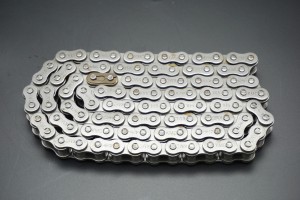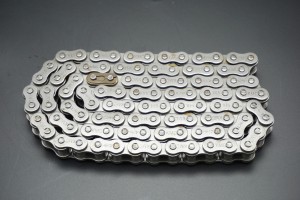Introduction to the basic parameters of roller chain transmission
Preface
Roller chain transmission is a widely used mechanical transmission method. It is favored in the industrial field because of its compact structure, high transmission efficiency and strong load-bearing capacity.
1. Basic structure and composition of roller chain
Roller chain usually consists of inner chain plate, outer chain plate, pin, sleeve and roller. The inner chain plate and sleeve, the outer chain plate and pin are interference fit, while the roller and sleeve, sleeve and pin are clearance fit. This structural design enables the roller chain to flexibly engage with the sprocket during operation, reduce wear and improve transmission efficiency.
2. Basic parameters of roller chain transmission
(I) Pitch (P)
Pitch is one of the most basic parameters of roller chain. It refers to the distance between the centers of two adjacent pins on the chain. The size of the pitch directly affects the load-bearing capacity and transmission performance of the roller chain. Generally speaking, the larger the pitch, the stronger the load-bearing capacity of the roller chain, but the corresponding impact and vibration will also increase. Therefore, when designing a roller chain transmission system, it is necessary to reasonably select the pitch size according to the actual load requirements and working environment.
(ii) Roller outer diameter (d1)
The roller outer diameter is the key dimension when the roller chain is meshed with the sprocket. The appropriate roller outer diameter can ensure good contact between the roller chain and the sprocket, reduce wear, and improve the stability and reliability of the transmission.
(iii) Inner link inner width (b1)
The inner link inner width refers to the inner width of the inner link. This parameter has an important influence on the strength and stability of the roller chain. When designing and selecting a roller chain, it is necessary to select the appropriate inner link inner width according to the actual load conditions and working environment.
(iv) Pin diameter (d2)
The pin diameter is the outer diameter of the pin in the roller chain. As one of the key components of the roller chain, the diameter of the pin directly affects the load capacity and service life of the roller chain.
(v) Chain plate height (h2)
The chain plate height refers to the vertical height of the chain plate. This parameter plays an important role in the overall strength and stability of the roller chain. In practical applications, it is necessary to select the appropriate chain plate height according to the load-bearing requirements and working environment of the roller chain.
(VI) Ultimate tensile load (Qmin) Ultimate tensile load refers to the maximum load that the roller chain can withstand in a tensile state. This parameter is an important indicator for measuring the load-bearing capacity of the roller chain. When selecting a roller chain, it is necessary to ensure that its ultimate tensile load can meet the maximum load requirements in actual work.
(VII) Mass per meter (q) Mass per meter refers to the mass per meter of the roller chain. This parameter has an important influence on the inertia force and transmission efficiency of the roller chain. When designing a roller chain transmission system, it is necessary to comprehensively consider the relationship between mass per meter and transmission efficiency and select a suitable roller chain.
3. Design and selection of roller chain transmission
(I) Design steps
Determine the transmission ratio: Determine the transmission ratio between the driving sprocket and the driven sprocket according to the operating requirements of the mechanical equipment.
Select the chain number: Select the appropriate roller chain number according to the transmission power and chain speed. The chain number corresponds to the pitch, and different chain numbers are suitable for different load and speed ranges.
Calculate the number of chain links: Calculate the required number of chain links based on the number of teeth and center distance of the sprocket. The number of chain links is generally an even number to avoid using transition chain links.
Check strength: Check the strength of the selected roller chain to ensure that it can withstand the maximum load in actual work.
(II) Selection considerations
Working environment: Consider the working environment of the roller chain, such as temperature, humidity, dust, etc. Roller chains working in harsh environments need to select products with corresponding protective properties.
Lubrication conditions: Good lubrication can effectively reduce the wear of the roller chain and increase its service life. Therefore, it is necessary to consider the lubrication conditions when selecting and choose the appropriate lubrication method.
Installation accuracy: Roller chain transmission has high requirements for installation accuracy. During installation, it is necessary to ensure the parallelism of the sprocket and the tension of the chain.
4. Application fields of roller chain transmission
Roller chain transmission is widely used in mechanical transmission such as agriculture, mining, metallurgy, petrochemicals, lifting and transportation, and various vehicles. It can transmit a wide range of power and is often used in occasions with power below 100kW; the chain speed can reach 30~40m/s, and the commonly used chain speed is below 15m/s; the maximum transmission ratio can reach 15, generally less than 6, and 2~2.5 is appropriate.
5. Advantages and limitations of roller chain transmission
(I) Advantages
High transmission efficiency: Compared with belt transmission, roller chain transmission has no elastic sliding, can maintain an accurate average transmission ratio, and has a high transmission efficiency, generally up to 96%~97%.
Large load-bearing capacity: roller chain transmission can withstand large loads and is suitable for low-speed and heavy-load working occasions.
Strong adaptability: roller chain transmission can work normally in harsh working environments, such as oily, dusty, high temperature, etc.
(II) Limitations
The instantaneous transmission ratio is not constant: the instantaneous chain speed and instantaneous transmission ratio of roller chain transmission are variable, the transmission stability is poor, and impact and noise may occur during work.
High installation accuracy requirements: roller chain transmission has high installation accuracy requirements. Improper installation may cause unstable transmission or even failure.
Not suitable for high-speed occasions: Since the instantaneous transmission ratio of roller chain transmission is not constant, it is not suitable for use in high-speed occasions.
6. Maintenance and care of roller chain transmission
In order to ensure the normal operation and extend the service life of the roller chain transmission system, regular maintenance and care are required. Mainly include the following points:
Regularly check the tension of the chain: Ensure that the tension of the chain meets the requirements and avoid being too loose or too tight.
Maintain good lubrication: Regularly add or replace lubricating oil to ensure good lubrication between the chain and the sprocket.
Check the wear of the chain: Regularly check the wear of the chain and replace the chain with severe wear in time.
Clean the chain and sprocket: Clean the chain and sprocket regularly to remove oil and impurities on the surface to prevent aggravated wear caused by impurities.
7. Summary
As an efficient and reliable mechanical transmission method, roller chain transmission has been widely used in the industrial field. The selection and design of its basic parameters play a key role in the performance and reliability of the transmission system. When choosing roller chain products, international wholesale buyers need to comprehensively consider the basic parameters of roller chains according to actual application requirements and working environment to ensure that the purchased roller chains can meet the operating requirements of mechanical equipment. At the same time, reasonable maintenance and care are also important guarantees to ensure the long-term stable operation of roller chain transmission systems….
Post time: Jul-25-2025

